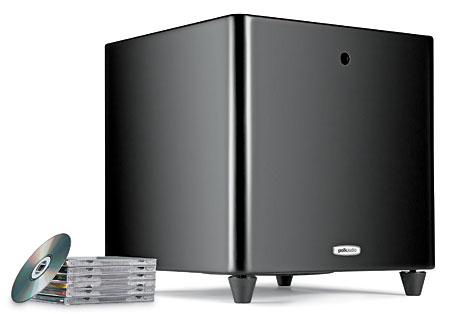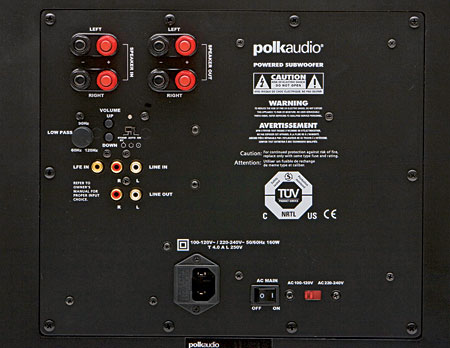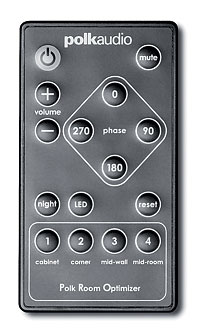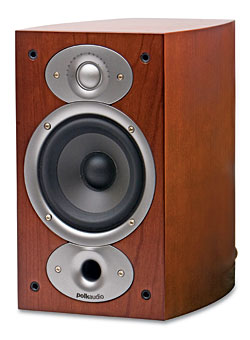Polk RTi A1 Speaker System Page 2

The DSW PRO 500 subwoofer measures more than 15 inches on all sides. By the standards of current fashion, that’s a pretty big enclosure. It houses a single 10-inch driver and slot-shaped port, both of which are down-firing. In the back are full sets of line- and speaker-level stereo inputs and outputs. There’s also an LFE input that bypasses the crossover, if you’d prefer to set that in your A/V receiver. The coolest feature is the credit-card-shaped remote, which includes buttons for power, volume, mute, reset, control of the blue front-panel LED, and a Night mode that reduces the sub’s level. For phase, you don’t get just two settings but four: 0, 90, 180, and 270 degrees. This gives you a better shot at getting the sub to perform well with the rest of the speakers.

Also on the remote are four buttons for the Polk Room Optimizer, with four preset equalization curves. They include: Cabinet, Corner, Mid-Wall, and Mid-Room. I ended up using the Mid-Wall setting as the best fit for my sub placement. (If you want to measure the sub in your room with a microphone and really dial in the correction, other Polk subs offer more advanced AUTOPRO Room Resonance Correction.)
 Associated equipment included a Rotel RSX-1550 A/V receiver and OPPO BDP-83SE universal disc player. All movie selections were on Blu-ray Disc.
Associated equipment included a Rotel RSX-1550 A/V receiver and OPPO BDP-83SE universal disc player. All movie selections were on Blu-ray Disc.
Mandela, Morgan, and Matt
Invictus is the real-life story of Nelson Mandela and a beleaguered rugby team he bonded with to heal the racial wounds of the reformed South African state. Let me note in passing how annoying it was that I couldn’t chapter-skip the opening fillers, including an ad for Digital Copy and several previews. At the first sound of Morgan Freeman’s voice on the DTS-HD Master Audio soundtrack, I identified him as the actor, but after only a few minutes, I thought of him as Mandela—so quietly powerful was the performance. The Polks united all of the soundtrack’s human elements: the naturalness of individual speaking voices, the physical palpability of massed singing voices in a meeting room, and washes of emotion-charged rugby crowd noise. A brief snatch of the Soweto String Quartet was warm and listenable. When drums quietly punctuated the action, the sub delivered them in a discernibly deep and tuneful manner. Athletes in close contact with one another and the ground evoked meaty thunks.
It would be wrong to say that the RTi A1 imposed a subjective warmth on everything that went through it. The Dolby TrueHD soundtrack of Pandorum, a viscerally violent lost-in-space story, often sounded quite harsh. Effects included some discomfort-inducing hisses. There were also some cool effects, such as a front-to-back spaceship trajectory. The whole thing was mastered at a uniformly high level, a lot like bad pop music that’s been dynamically flattened for use in an iPod. The speakers (and the lossless surround codec) merely told the truth about this sonically below-par material.
Well-cast animated movies like Igor—in this case, another DTS-HD Master Audio soundtrack—offer numerous chances to play spot-the-actor. I had fun identifying John Cusack, Steve Buscemi, John Cleese, Molly Shannon, Christian Slater, and Jay Leno. This speaker system made easy work of delivering familiar voices. The movie has more charm than the reviews suggest.
 Smoothie
Smoothie
Probably the most revealing piece of demo material was the set of five Saint-Saëns piano concertos with pianist Anna Malikova and Thomas Sanderling conducting the WDR Sinfonieorchester Köln. The two-disc Audite SACD release is a 5.1-channel recording that dates from 2003. Once again, the Polks asserted their by-now-familiar smoothness. With this somewhat slick recording, it was almost too much of a good thing. No matter how high I pushed the volume, there was something intangible and fleeting about the string sound. I wouldn’t call it gauzy or unduly vague. Still, it never quite defined the concert-hall space, despite the fact that I used matched speakers all around. The mids and highs didn’t induce fatigue, but they were also airless. Of course, there are limits to what you can get out of a $170 speaker. The RTi A1 did better than many of its similarly priced competitors, and if it erred at all, it was on the side of listening comfort. Modest low-frequency information from the basses wasn’t sufficient to trigger the sub’s auto-on feature: It needed a little help from the remote.
The Live in Concert DVD by Hiromi’s Sonic-bloom comes with a stereo PCM soundtrack that I played in the Dolby Pro Logic II Music mode. I’ve been a fan of the young Japanese jazz pianist for a long time through her multichannel SACDs, but I’ve never seen her live. It was a revelation to see how animated she is—like a Leonard Bernstein of the keyboard. This clearly electrified the audience while driving every band member to ever greater heights of euphoric soloing. Keyboard textures were varied, with electric piano and two small synths complementing the main instrument. The speakers made the nervy electronic textures as palatable as the purely acoustic ones. Wah-wah bass effects emerged pleasingly from the sub.
There seem to be two John Joneses in the music world. One is a Canadian record producer who has worked with Duran Duran and Celine Dion. The other one is the lead singer of Oysterband. The latter Jones steps into solo territory with the surprisingly unfolky Rising Road. Given the choice between expensive import CD and reasonably priced download, I opted for none of the above. Instead, I snagged a used CD. Jones’ rich tenor emerged in all of its distinctive beauty. The sub delivered bass-drum thuds convincingly. I was happy with the result.
The Polk RTi A1 is probably the most well thought-out and elaborately constructed speaker in the budget genre. It earns top marks for both build quality and value. If you’re looking to mate a set of speakers with a sub-$500 A/V receiver, the RTi A1 is a logical choice. But if you’re spending more than that for a better AVR, I’d strongly recommend that you step up from these monitors to the Polk LSi7 ($800 per pair). They’re more than worth the difference in price. Either way, you’ll get unbeatable value for your money.





























































